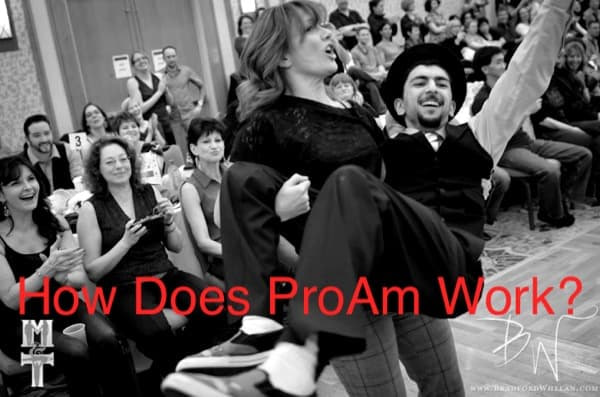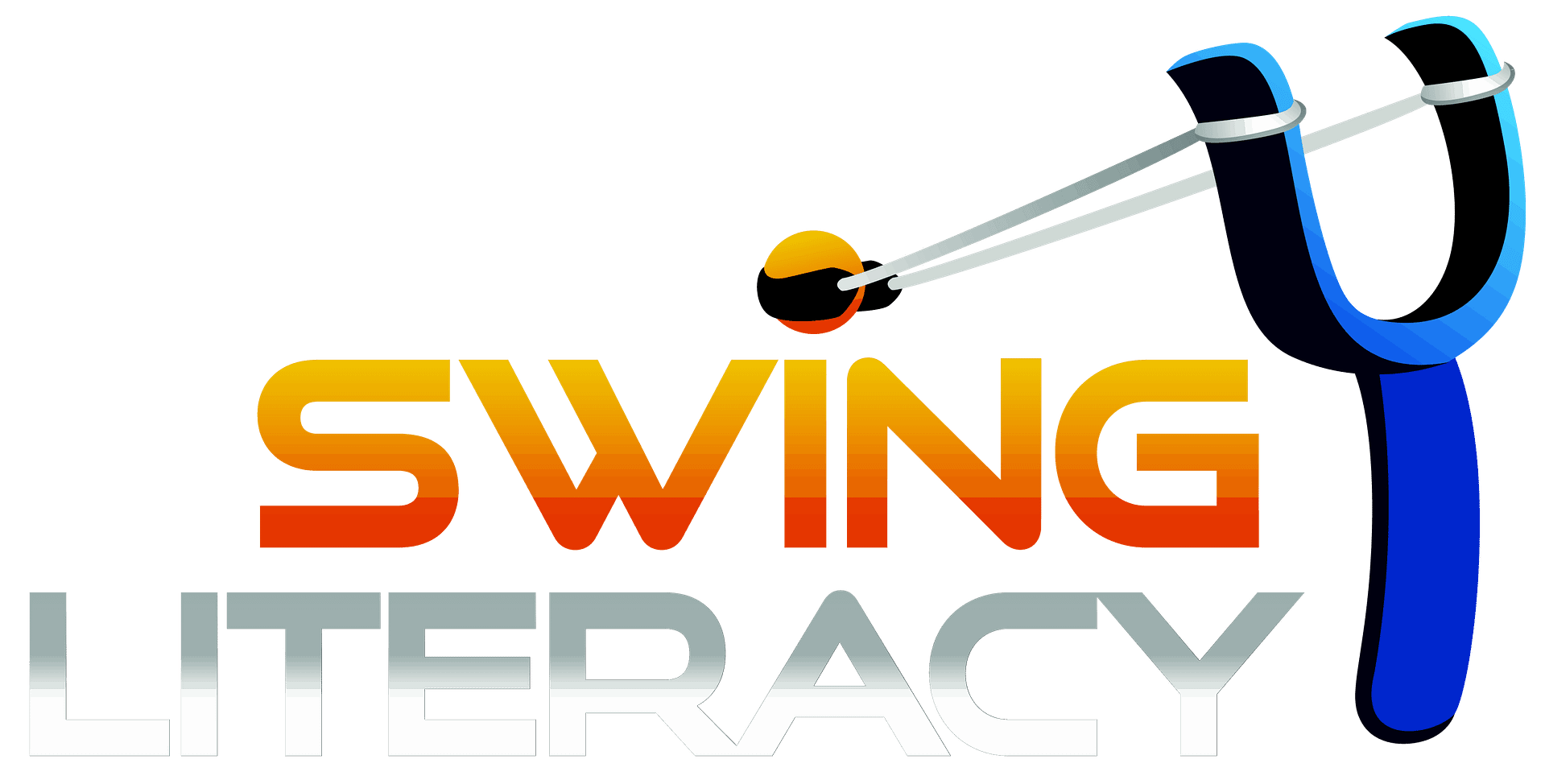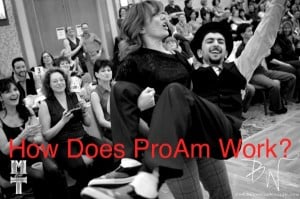No products in the cart.

How Does ProAm Work?
Reading Time: minutes remaining
It seems kinda elite, at first glance. You see it on the schedule, but it only involves certain people, but there seems to be no rhyme or reason to who gets to do this mysterious contest.
When I first started dancing I had all kinds of hypotheses about what “ProAm” was. Coming from the west coast, it was the Country Western dancers that explained it to me. There was a whole world of contests out there to which I now had an all-access pass!
Now, even though it’s not a new concept, we have new students asking tentatively all the time about this ProAm thing they see at conventions – Is it for everyone? Can they do it too? Are they ready? Will we dance with them? So here’s the low-down to satisfy everyone’s curiosity.
What is Pro-Am?
ProAm is a common category of competition in Ballroom/Latin and CountryWestern that some regions of the West Coast Swing world have adopted, but not all. The word is an abbreviation for Professional-Amateur and just refers to a student partnering with their teacher for a contest.
There are several types of contests (choreo and improv) in which Pro’s can compete with Am’s, but there is no consistency or regulation amongst events like there is for WSDC Jack & Jills. Not every event hosts ProAm contests, and each event interprets the contests differently.
A Little Background
In the Ballroom and Country Western worlds, ProAm originally only referred to routines. The division was created to serve the students who didn’t have a partner but who wanted to work on a project to improve their dancing, or to train to be competitive until they found a partner of their own level.
This was a win-win-win situation: students would be happy because they get to train and dance with an exceptionally competent partner, teachers would be happy for more business in creating, practicing and competing with routines, and events would be happy for the increased registration numbers that ProAm would bring.
The plan backfired a bit, though: students were so successful with their teachers that they were less motivated to find a partner of their own level to compete with. ProAm became so popular in Ballroom and Country that events had to start contests at 7am or start weekends on Tuesday just to fit in all the ProAm entries. Pros were now so busy prepping their ProAm students, their social dancing became non-existent, as did their students’, which severely hurt the social dance atmosphere at events.
For better or worse, West Coast Swing has not experienced the same saturation, mostly due to the emphasis it places on improvised Jack & Jill competition. Hopefully it will never get to that point! WCS has developed its own version of ProAm contests, which follow the typical, less demanding, WCS competition formats.
ProAm Jack & Jill
This is simply an Open Jack & Jill, where the Amateur dancers randomly draw for or rotate to a Pro partner. It runs in a heated format, usually in 2 heats: male Pros with female Ams, and female Pros with male Ams. They may or may not be combined for finals, depending on the event’s rules.
Advantages:
- This is a fun, no-commitment way to get some great dances with a Pro (or several) you don’t normally get access to.
- All the pros are experts at elevating their partners and making them dance better than they thought they could.
- How cool would it be to stand on the podium for awards holding a trophy you won with your idol?
ProAm Strictly
Like Strictly Swing, this division involves predetermined partnerships but random music and no choreography. Dancers enter by their WSDC division. Usually, teachers have multiple students to dance with, which means there are multiple small heats instead of few large heats. It is quite common for there to be only 1-4 couples competing on the floor at a time. Each heat usually gets only one song, occasionally two. The students dress appropriately for Jack & Jill, but the teachers typically wear black so that they highlight their Am.
Judging
The judges only judge the dancing of the Am, not the partnership, however it is possible that the Pro’s bad habits could negatively impact the Am and prevent him/her from scoring well. The judging system varies, depending on the rules of the event.
Some ProAm Strictlys are judged exactly like a Strictly final, where the judges are asked to rank each competitor against the field. Awards are allocated based on judges’ relative placement scores.
In other ProAm Strictly contests, the Ams are given a grade like in school (Bronze, Silver, Gold, Gold with Honours), which indicates their competency within the expectations of the division level, and is not related to the other competitors. Awards are allocated based on these competency levels, usually in the form of certificates. There is no universal criteria for competency levels, so the judges are simply using an educated guess.
How do I start?
Teachers might extend an invitation to their regular students to do ProAm Strictly, but otherwise it is up to the student to invite the teacher. Typically, Ams will ask their regular teacher to dance with them in the ProAm Strictly. But it is also common for Ams to ask a Pro to dance who is not their regular teacher: 1) because they live far away and don’t get access to them very often, or 2) they want to experience the challenge and thrill of dancing with someone new, or higher level.
Every Pro has their own “rules” about how they operate with ProAm Strictly, and the only way to find out is to ask them directly. Some teachers will charge a service fee for prepping the student and competing in ProAm, while others will dance for free, as long as the student has taken lessons with them already. In all cases, it is the Am who pays for the contest registration fee.
Advantages
- Experience the challenge and thrill of dancing with one of your idols
- Get to compete with an ideal partner who can fix all your mistakes
- Depending on the judging system, you can gauge your own improvement
- Get your feet wet competing for the first time with your trusted teacher before trying J&J
- Learning what each of the Pros feels like and prefers from their partners
ProAm Routines
This routine division is the same as Classic or Showcase, and it is the most “serious” of all the ProAm contests. It involves choreography, costumes, and a ton of practice. Sometimes, students work on a routine with their teacher as part of their dance progress plan, but with no intention of ever competing. Some events offer a ProAm routine division, although this is more common in some regions than others. This contest may or may not be segregated by WSDC division.
Judging
Couples dance in spotlight format, with their own pre-selected music. The Pro’s choreography is designed to highlight the Am’s strengths and offer an attainable challenge without overreaching their abilities. The judges judge both the suitability of the choreography and the Am’s ability to execute it well. Dancers are ranked by relative placement, same as in Classic/Showcase.
How do I start?
Ask your regular teacher if they do ProAm routines. Not every teacher does. Some teachers don’t choreograph, in which case they will agree to dance with you but you need to get choreography from another Pro. This is quite common. You might also consider asking another Pro besides your regular teacher to partner with you for a ProAm routine. This can work well if your regular teacher is willing to coach you on the choreography in between practices with your ProAm partner. This could also work in reverse: your regular teacher choreographs the routine and dances with you, but you both take private lessons together from a higher level Pro to get coaching on refinement.
Each Pro has their own “rules” about how they operate with ProAm routines. Some will charge a separate choreography fee, while others might just work on the routine during regular private lessons. In all cases, it is the Am who pays for the 4 C’s: contest registration, choreography, coaching, and costumes. If the Am wants to attend and dance ProAm at an event for which the Pro is not already on staff, the Am is typically responsible for paying the expenses for the Pro to attend the event. If the Pro has multiple Ams, the weekend expenses get split among them.
Advantages
- Improving your skills via choreography: using repeatable sequences to measure improvement
- Partnering with an expert who can cater to your strengths and weaknesses
- Challenging yourself to step outside your comfort zone, with a trusted supporter
- Preparing for being in the spotlight, working on artistry and showmanship in your private lessons
- Advertising your skills to judges and potential future partners.
Classifications
What classifies a “Professional” and an “Amateur”? In the Ballroom and Country Western worlds, this is very clear, a Professional is anyone who receives money for partner dancing services. But in the WCS world, where career dancers are more rare, the classifications are widely debatable and vary from event to event. Your “Pro” could be your regular teacher who has a civilian full-time job but just teaches a few WCS classes on Tuesday evenings.
Events usually stipulate their definition of “Pro” in their rules package, but many events leave it up to the contestants to decide. Some events consider anyone who has ever competed in an Open division, Classic/Showcase, or Champions/Invitational J&J to be a Pro, regardless of their teaching experience. World Swing Dance Council recommends that a teacher should be WSDC Advanced level or higher to be considered as a Pro.
Prizes
Trophy awards are common, but prize money varies – sometimes there is no prize money, sometimes only the Am wins prize money, and sometimes both the Pro and the Am win prize money. In Ballroom, the prize money defines the professional status: Amateur dancers are not allowed to accept prize money if they want to keep their Amateur status, so any winnings they get goes to their Pro, who usually converts it into more private lessons for them. In WCS, this is not so strict, as there is no governing body regulating or recording ProAm competitions.

You must be logged in to post a comment.


Thanks for the great information!
Regarding Strictly ProAms, do you have perspectives on paying or giving a gratuity to the Pro?
I sometimes (whenever mutually convenient) ProAm with the Pro I weekly take private lessons from. Based on the regular paid relationship and other gratuities flowing from this relationship, I don’t feel the need to compensate for the ProAms. The Pro also suggests the ProAms and has never intimated for additional compensation or gratuity.
BUT I’m thinking of especially when/if I ask “random” Pro ….
I know that some Pros have a policy of at least a paid private lesson before the ProAm.
What say you?
Thanks Tim, you’re welcome and thanks for your question. Generally, independent social dance instruction is not a “tipping” industry. As an independent dance teacher, we set our own prices and keep all the money, so tipping is redundant and unnecessary. However, a dance teacher who is affiliated with a studio gets paid by the studio a fraction of what the student pays for their lessons, so in this case a tip might be appreciated, if it is permitted.
As for my own personal ProAm policy: I take pride in my teaching and view ProAm as an educational experience, not only a chance to share the spotlight with a Pro. For this reason, I prefer to give potential Ams the benefit of my teaching before we compete on ProAm. I also want to protect my physical safety and my brand: An Am’s bad habits can reflect poorly on the Pro. I don’t want to endorse a dancer who hasn’t given me a chance to work on their bad habits.